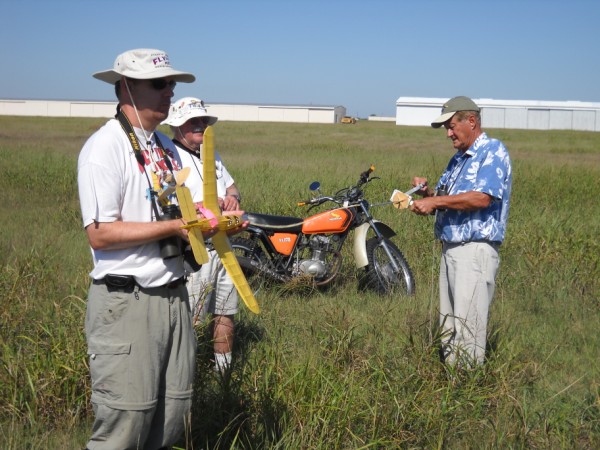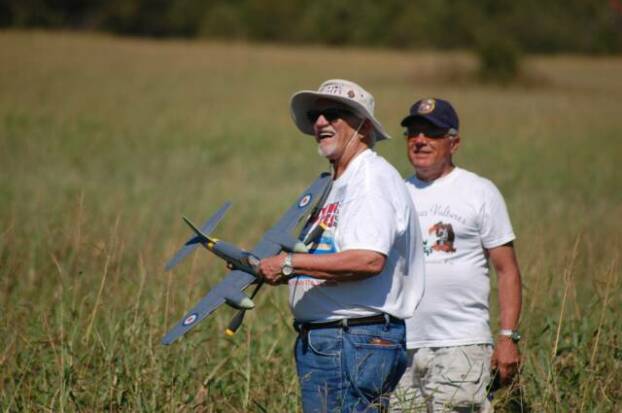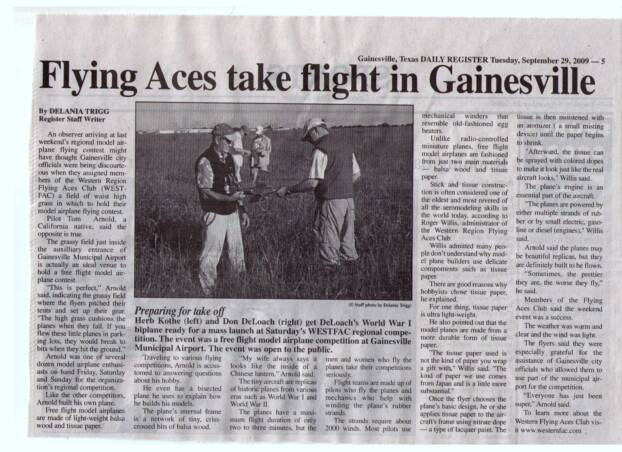WESTFAC II Press Releases
From the Gainseville Daily Register September 29, 2009
Flying Aces land in Gainesville for regional competition
By DELANIA TRIGG, Register Staff Writer
An observer arriving at last weekend’s regional model airplane flying contest might have thought Gainesville city officials were being discourteous when they assigned members of the Western Region Flying Aces Club (WESTFAC) a field of waist high grass in which to hold their model airplane flying competition.
Pilot Tom Arnold, a California native, said that’s not the case.
The grassy field just inside the auxilliary entrance of Gainesville Municipal Airport is actually an ideal venue to hold a free flight model airplane contest.
“This is perfect,” Arnold said, indicating the grassy field where the flyers pitched their tents and set up their gear. “The high grass cushions the planes when they fall. If you flew these little planes in parking lots, they would break to bits when they hit the ground.”
Arnold was one of several dozen model airplane enthusiasts on hand Friday, Saturday and Sunday for the organization’s regional competition.
WESTFAC
Western Region Flying Aces
Like the other competitors, Arnold built his own plane.
Free flight model airplanes are made of light-weight balsa wood and tissue paper.
Traveling to various flying competitions, Arnold is accustomed to answering questions about his hobby.
He even has a bisected plane he uses to explain how he builds his models.
The plane’s internal frame is a network of tiny, criss-crossed bits of balsa wood.
“My wife always says it looks like the inside of a Chinese lantern,” Arnold said.
The tiny aircraft are replicas of historic planes from various eras such as World War I and World War II.
The planes have a maximum flight duration of only two to three minutes, but the men and women who fly the planes take their competitions seriously.
Flight teams are made up of pilots who fly the planes and mechanics who help with winding the plane’s rubber strands and keeping track of flight times with a stop watch.
Winding the strands requires about 2000 winds. Most pilots use mechanical winders that resemble old-fashioned egg beaters.
Unlike radio-controlled miniature planes, free flight model airplanes are fashioned from just two main materials — balsa wood and tissue paper.
Stick and tissue construction is often considered one of the oldest and most revered of all the aeromodeling skills in the world today, according to Roger Willis, administrator of the Western Region Flying Aces Club.
Willis admitted many people don’t understand why model plane builders use delicate compoments such as tissue paper.
There are good reasons why hobbyists chose tissue paper, he explained.
For one thing, tissue paper is ultra light-weight.
He also pointed out that the model planes are made from a more durable form of paper.
"The tissue paper used is not the kind of paper you wrap a gift with," Willis said. "The kind of paper we use comes from Japan and is a little more substantial."
Once the flyer chooses the plane’s basic design, he or she applies tissue paper to the aircraft's frame using nitrate dope — a type of lacquer paint. The tissue is then moistened with an atomizer ( a small misting device) until the paper begins to shrink.
"Afterward, the tissue can be sprayed with colored dopes to make it look just like the real aircraft looks," Willis said.
The plane’s engine is an essential part of the aircraft.
"The planes are powered by either multiple strands of rubber or by small electric, gasoline or diesel (engines)," Willis said.
Arnold said the planes may be beautiful replicas, but they are definitely built to be flown.
“Sometimes, the prettier they are, the worse they fly,” he said.
Members of the Flying Aces Club said the weekend event was a success.
The weather was warm and clear and the wind was light.
The flyers said they were especially grateful for the assistance of Gainesville city officials who allowed them to use part of the municipal airport for the competition.
“Everyone has just been super,” Arnold said.
To learn more about the Western Flying Aces Club visit www.westernfac.com



